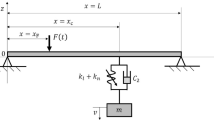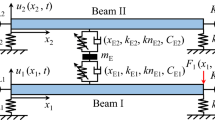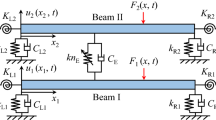Abstract
A practical double-beam system coupled with prestressed linear and buckled beams with fixed–fixed ends is innovatively designed to enhance damping and suppress the dynamic response. Considering nonlinear geometric relations, a linear-bistable coupled model is derived for this system. When the force amplitude of harmonic excitation exceeds the critical value, the double-beam system undergoes chaotic motion, and the vibration energy is distributed over a wide frequency band, which results in a reduction in the vibration amplitude that is much smaller than that of a linear double-beam system with the same damping coefficient and initial stiffness. After the force amplitude of harmonic excitation reaches the upper critical value, the bistable layer enters the state of combined inter- and in-well oscillation, which strongly enhances the dissipation of the viscoelastic core layer and significantly suppresses the vibration of the linear beam. By developing the Melnikov method and the harmonic balance method, the chaotic and non-chaotic edges of the steady-state vibration of this double-beam system can be analytically detected and numerically verified. Numerical studies reveal the influence of the parameters of the viscoelastic layer and axial force on vibration suppression. This investigation provides an adjustable methodology to suppress dynamic responses in beam-type structures.













Similar content being viewed by others
References
Pais, T., Boote, D.: Developments of tuned mass damper for yacht structures. Ocean. Eng. 141, 249–264 (2007)
Mohammad, R.P., Hozhabrossadati, S.M.: Analytical and numerical method for free vibration of double-axially functionally graded beams. Compos. Struct. 152, 488–498 (2016)
Arani, A.G., Dashti, P., Amir, S., Yousefi, M.: Nonlinear vibration of coupled nano- and microstructures conveying fluid based on Timoshenko beam model under two-dimensional magnetic field. Acta. Mech. 226(8), 2729–2760 (2015)
Ghazaryan, D., Burlayenko, V.N., Avetisyan, A., Bhaskar, A.: Free vibration analysis of functionally graded beams with non-uniform cross-section using the differential transform method. J. Eng. Math. 110, 97–121 (2018)
Pavlović, I., Pavlović, R., Kozić, P., Janevski, G.: Almost sure stochastic stability of a viscoelastic double-beam system. Arch. Appl. Mech 83(11), 1591–1605 (2013)
Fang, H., Meng, X.J., Duan, L.Y., Liu, Y.: Enhanced dissipation of a jacket platform provided by a steel brace containing a multistable bilayered column. Ocean. Eng. 203, 107244 (2020)
Thomas, G., Davis, M., Holloway, D., Roberts, T.: The vibratory damping of large high-speed catamarans. Mar. Struct. 21(1), 1–22 (2008)
Lakes, R.S.: Viscoelastic Materials. Cambridge University Press, Cambridge (2009)
Kandasamy, R., Cui, F., Townsend, N., Foo, C.C., Guo, J., Shenoi, A., Xiong, Y.: A review of vibration control methods for marine offshore structures. Ocean. Eng. 127, 279–297 (2016)
Vergassola, G., Boote, D., Tonelli, A.: On the damping loss factor of viscoelastic materials for naval applications. Ships. Offsh. Struct 13(5–6), 466–475 (2018)
Dai, P.D.: Vibration damping and noise reduction technology. X’ian Jiaotong University Press, X’ian (1988)
Ni, Z.H.: Mechanics of vibration. X’ian Jiaotong University Press, X’ian (1990)
Ibrahim, R.A.: Recent advances in nonlinear passive vibration isolators. J. Sound. Vib. 314(3–5), 371–452 (2008)
Fang, H., Wu, R.X., Duan, L.Y., Liu, Y.: Analytical and numerical investigation of a steel module with a postbuckling transition mechanism for dynamic dissipation. J. Struct. Eng. 146, 04020115 (2020)
Masana, R., Daqaq, M.F.: Electromechanical modeling and nonlinear analysis of axially loaded energy harvesters. J. Vib. Acoust. 133, 011007 (2011)
Nayfeh, A.H.: Linear and Nonlinear Structural Mechanics. Wiley, New Jersey (2004)
Kidambi, N., Harme, R.L., Wang, K.W.: Adaptation of energy dissipation in a mechanical metastable module excited near resonance. J. Vib. Acoust. 138, 011001 (2016)
Romeo, F., Manevitch, L.I., Bergman, L.A., Vakakis, A.: Transient and chaotic low-energy transfers in a system with bistable nonlinearity. Chaos 25, 053109 (2015)
Jin, X.D., Xia, L.J.: Vibration of ship. Shanghai Jiaotong University Press, Shanghai (2011)
Masana, R., Daqaq, M.F.: Relative performance of a vibratory energy harvester in mono- and bi-stable potentials. J. Sound. Vib. 330, 6036–6052 (2011)
Li, D.J., Fang, H., Duan, L.Y.: High structural damping based on the internal snap-buckling mechanism of a continuous metal module. Mech. Res. Commun. 105, 103514 (2020)
Ziaee, S.: The steady-state response of size-dependent functionally graded nanobeams to subharmonic excitation. J. Eng. Math. 104, 19–39 (2017)
Acknowledgments
This work was supported by the NSFC (51979258).
Author information
Authors and Affiliations
Corresponding author
Ethics declarations
Conflict of interest
The authors declare that they have no known competing financial interests or personal relationships that could have appeared to influence the work reported in this paper.
Additional information
Publisher's Note
Springer Nature remains neutral with regard to jurisdictional claims in published maps and institutional affiliations.
Rights and permissions
About this article
Cite this article
Fang, H., Liu, Z. & Duan, L. Enhanced dissipation in a double-beam system with a bistable constraint. Arch Appl Mech 92, 885–901 (2022). https://doi.org/10.1007/s00419-021-02079-w
Received:
Accepted:
Published:
Issue Date:
DOI: https://doi.org/10.1007/s00419-021-02079-w




